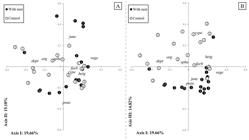ABSTRACT
Male gladiator frogs of Hypsiboas Wagler, 1830 build nests on available substrate surrounding ponds and streams where female spawn eggs during the breeding period. Although gladiator frogs seem to show plasticity in the way they construct their nests, there is no study reporting if these species present preferences about microhabitat conditions for nest-building (mainly under subtropical climate). Predation pressure and environmental conditions have been considered major processes shaping the great diversity of reproductive strategies performed by amphibians, but microhabitat conditions should explain where to build a nest as well as how nest looks. This study aimed to test nest site selection for nest-building by Hypsiboas faber(Wied-Neuwied, 1821), determining which factors are related to nest site selection and nest features. The survey was conducted at margins of two permanent ponds in Southern Brazil. Habitat factors were evaluated in 18 plots with nest and 18 plots in the surrounding without nest (control), describing vegetation structure and heterogeneity, and substrate characteristics. Water temperature was measured inside the nest and in its adjacency. Nest features assessed were area, depth and temperature. Habitat characteristics differed between plots with and without nest. Microhabitat selected for nest-building was characterized by great vegetation cover and height, as well as shallower water and lower cover of organic matter in suspension than in plots without nest. Differences between temperature inside nest and in its adjacency were not observed. No relationship between nest features and habitat descriptors was evidenced. Results revealed that Hypsiboas faber does not build nests anywhere. Males seem to prefer more protected habitats, probably avoiding predation, invasion of conspecific males and inclement weather. Lack of differences between temperature inside- and outside-nest suggest that nest do not improve this condition for eggs and tadpole development. Nest architecture was not related to habitat characteristics, which may be determined by other factors, as nest checking by females before amplexus. Nest site selection should increase offspring survival as well the breeding success of Hypsiboas faber.
KEYWORDS
Amphibian reproductive modes; Anura life-history; nest-building anurans; nest features; oviposition site

 Thumbnail
Thumbnail
 Thumbnail
Thumbnail



